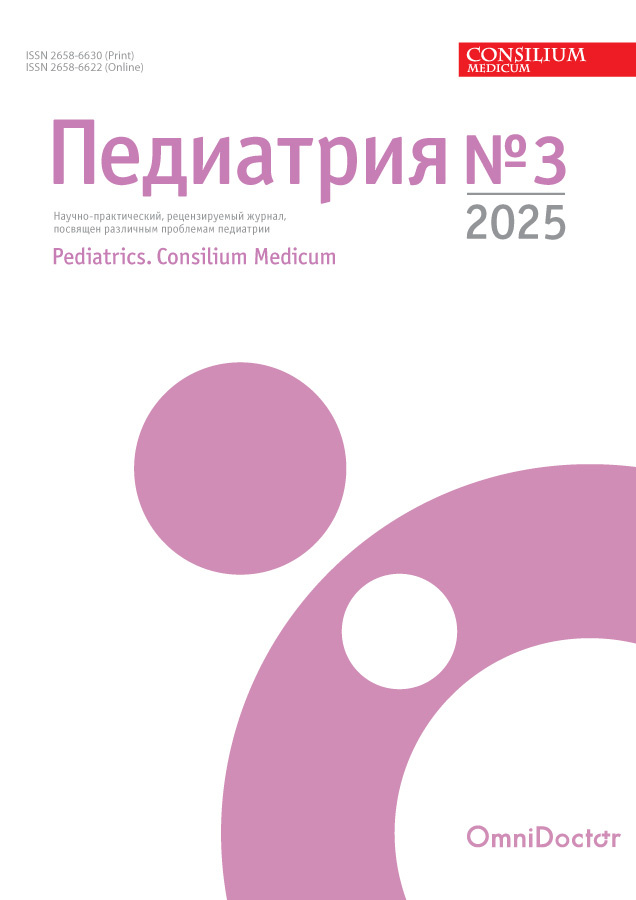Предупрежден, значит вооружен. Экстравазация как осложнение инфузионной терапии в педиатрической практике. Обзор литературы и клинические примеры
- Авторы: Оборкина Д.С.1,2, Будкевич Л.И.1,2, Сошкина В.В.2, Мирзоян Г.В.2, Астамирова Т.С.2
-
Учреждения:
- Российский национальный исследовательский медицинский университет им. Н.И. Пирогова
- Детская городская клиническая больница №9 им. Г.Н. Сперанского
- Выпуск: № 3 (2025)
- Страницы: 202-207
- Раздел: Статьи
- URL: https://pediatria.orscience.ru/2658-6630/article/view/690032
- DOI: https://doi.org/10.26442/26586630.2025.3.203419
- ID: 690032
Цитировать
Полный текст
Аннотация
Экстравазация – процесс непреднамеренного попадания лекарственных средств в межсосудистое пространство. В зависимости от вещества данное явление может привести к некрозу тканей с развитием тех или иных осложнений. Дети, особенно новорожденные, подвержены экстравазации с частотой случаев до 46%, некроз мягких тканей развивается у 4% пострадавших, приводя к формированию рубцовых контрактур, деформаций и последующему ограничению, а в ряде случаев – к потере функции конечностей. В настоящее время отсутствуют руководства по лечению экстравазационных травм у детей. В нашей статье мы осветили последние данные литературы, используя ресурсы PubMed и GoogleScholar, а также собственный клинический опыт оказания помощи пациентам с неблагоприятными явлениями в результате экстравазации. Отсутствие рандомизированных контролируемых исследований по лечению детей с экстравазационными осложнениями, нежелание медицинских работников регистрировать данное явление в истории болезни искажают доказательную статистику. В зависимости от вещества, объема введенной жидкости и степени повреждения окружающих тканей варианты лечения могут быть разнообразными, включая не только консервативные, но и хирургические методы. К консервативным видам терапии относятся следующие манипуляции: введение антидотов, гиалуронидазы или вазодилататоров, процедура дренирования и промывания очага. Каждый клинический случай требует индивидуального подхода, а объем оказанной помощи должен быть достаточным и своевременным для уменьшения частоты тяжелых осложнений с калечащими исходами.
Ключевые слова
Полный текст
Об авторах
Дарья Сергеевна Оборкина
Российский национальный исследовательский медицинский университет им. Н.И. Пирогова; Детская городская клиническая больница №9 им. Г.Н. Сперанского
Автор, ответственный за переписку.
Email: daria100199@gmail.com
ORCID iD: 0000-0001-5021-9594
мл. науч. сотр. Научно-исследовательского клинического института педиатрии и детской хирургии им. акад. Ю.Е. Вельтищева; врач – детский хирург ожогового отд-ния для детей грудного возраста
Россия, Москва; МоскваЛюдмила Иасоновна Будкевич
Российский национальный исследовательский медицинский университет им. Н.И. Пирогова; Детская городская клиническая больница №9 им. Г.Н. Сперанского
Email: daria100199@gmail.com
ORCID iD: 0000-0002-8975-6108
д-р мед. наук, проф., гл. науч. сотр. Научно-исследовательского клинического института педиатрии и детской хирургии им. акад. Ю.Е. Вельтищева; зав. ожоговым отд-нием для детей грудного возраста
Россия, Москва; МоскваВера Владимировна Сошкина
Детская городская клиническая больница №9 им. Г.Н. Сперанского
Email: daria100199@gmail.com
ORCID iD: 0000-0002-8605-8670
канд. мед. наук, врач – детский хирург отд-ния для детей грудного возраста
Россия, МоскваГаянэ Владимировна Мирзоян
Детская городская клиническая больница №9 им. Г.Н. Сперанского
Email: daria100199@gmail.com
ORCID iD: 0009-0005-2229-215X
врач – детский хирург отд-ния для детей грудного возраста
Россия, МоскваТатьяна Сергеевна Астамирова
Детская городская клиническая больница №9 им. Г.Н. Сперанского
Email: daria100199@gmail.com
врач – детский хирург отд-ния для детей грудного возраста
Россия, МоскваСписок литературы
- Murphy AD, Gilmour RF, Coombs CJ. Extravasation injury in a paediatric population. ANZ J Surg. 2019;89(4):E122-6.
- Hackenberg RK, Kabir K, Müller A, et al. Extravasation Injuries of the Limbs in Neonates and Children – Development of a Treatment Algorithm. Dtsch Arztebl Int. 2021;118(33-4):547-54.
- Atay S, Sen S, Cukurlu D. Incidence of infiltration/extravasation in newborns using peripheral venous catheter and affecting factors. Rev Esc Enferm USP. 2018;52.
- Khan MS, Holmes JD. Reducing the morbidity from extravasation injuries. Ann Plast Surg. 2002;48:628-32.
- The Royal Children's Hospital Melbourne (2022) Peripheral extravasation injuries: Initial management and washout procedure. Available at: https://www.rch.org.au/clinicalguide/guideline_index/Peripheral_extravasation_injuries__Initial_management_and_washout_procedure/ Accessed: 28.04.2025.
- Millam DA. Managing complications of iv . therapy (continuing education credit). Nursing. 1988;18:34-43.
- Simona R. A pediatric peripheral intravenous infiltration assessment tool. J Infus Nurs. 2012;35:243-8.
- Leitlinienprogramm Onkologie (Deutsche Krebsgesellschaft, Deutsche Krebshilfe, AWMF) S3-Leitlinie „Supportive Therapie bei onkologischen PatientInnen – Langversion 1.3“. AWMF-Register-Nummer: 032/054OL. Available at: www.leitlinienprogramm-onkologie.de/fileadmin/user_upload/Downloads/Leitlinien/Supportivtherapie/LL_Supportiv_Langversion_1.3.pdf. Accessed: 20.04.2025.
- Kim JT, Park JY, Lee HJ, Cheon YJ. Guidelines for the management of extravasation. J Educ Eval Health Prof. 2020;17:21.
- Perez Fidalgo JA, Garcia Fabregat L, Cervantes A, et al. Management of chemotherapy extravasation: ESMO-EONS clinical practice guidelines. Ann Oncol. 2012;23:vii167-73.
- Denkler KA, Cohen BE. Reversal of dopamine extravasation injury with topical nitroglycerin ointment. Plast Reconstr Surg. 1989;84:811-3.
- Wong AF, McCulloch LM, Sola A. Treatment of peripheral tissue ischemia with topical nitroglycerin ointment in neonates. J Pediatr. 1992;121:980-3.
- Siwy BK, Sadove AM. Acute management of dopamine infiltration injury with Regitine. Plast Reconstr Surg. 1987;80:610-2.
- Thigpen JL. Peripheral intravenous extravasation: nursing procedure for initial treatment. Neonatal Netw. 2007;26:379-84.
- Yan YM, Fan QL, Li AQ, et al. Treatment of cutaneous injuries of neonates induced by drug extravasation with hyaluronidase and hirudoid. Iran J Pediatr. 2014;24:352-8.
- Hanrahan K. Hyaluronidase for treatment of intravenous extravasations: implementation of an evidence-based guideline in a pediatric population. J Spec Pediatr Nurs. 2013;18:253-62.
- Chandavasu O, Garrow E, Valda V, et al. A new method for the prevention of skin sloughs and necrosis secondary to intravenous infiltration. Am J Perinatol. 1986;3:4-5.
Дополнительные файлы
















